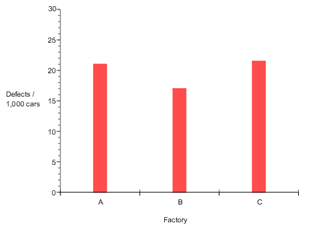Bar Graphs
| Site: | Clare-Gladwin RESD |
| Course: | Michigan Algebra II KHauck |
| Book: | Bar Graphs |
| Printed by: | Guest user |
| Date: | Friday, December 26, 2025, 4:25 PM |
Description
Bar Graphs
Bar Graphs
Bar graphs are used to show the comparison of categorical data. This type of graph consists of parallel bars or rectangles. The lengths of the bars correspond to the frequency with which specified quantities occur within a category of data. When creating a bar graph, the variable along the horizontal axis will usually be categorical while the vertical axis will usually have a quantitative variable.
Example The bar graph below represents the number of defects per 1,000 cars for three factories.

Along the horizontal axis the categorical variable is defined as factory A, B, or C. Along the vertical axis the quantitative variable is defined as number of defects per 1,000 cars.
Interactive Activity
Bar GraphsPractice
*Note: If Google Docs displays, “Sorry, we were unable to retrieve the document for viewing,†refresh your browser.
Answer Key
*Note: If Google Docs displays, “Sorry, we were unable to retrieve the document for viewing,†refresh your browser.
Sources
Sources used in this book:Embracing Mathematics, Assessment & Technology in High Schools; a Michigan Mathematics & Science Partnership Grant Project
Holt, Rinehart & Winston, "Displaying Data in a Double Bar Graph." http://my.hrw.com/math06_07/nsmedia/lesson_videos/msm3/player.html?contentSrc=6271/6271.xml (accessed 7/26/2010).
Shodor, "Histograms and Bar Graphs." http://www.shodor.org/interactivate/lessons/HistogramsBarGraph/ (accessed 7/26/2010).
Shodor, "Interactive: Bar Graph." http://www.shodor.org/interactivate/activities/BarGraph/ (accessed 7/26/2010).